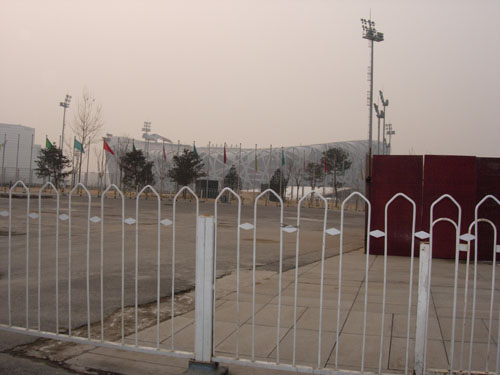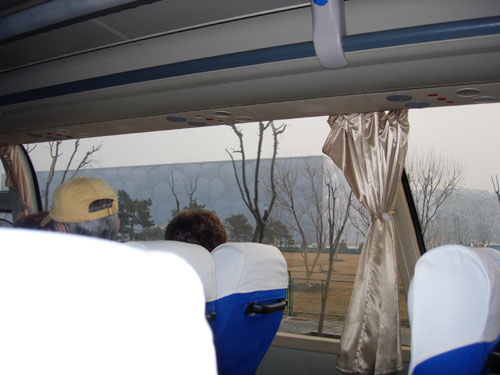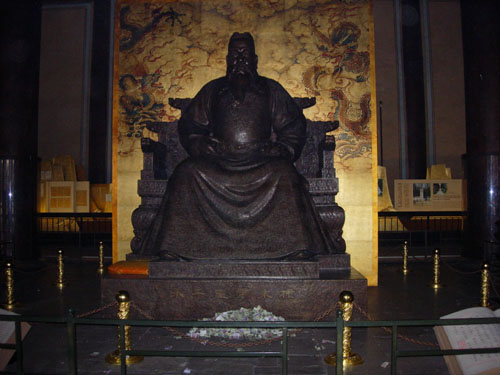|
|
|
"Other Colors"
by Orhan Pamuk
"Mayflower"
by Nathaniel Philbrick
"Body Wars"
by Margo Maine, Ph.D.
"Blink"
by Malcolm Gladwell
|
|
|
|
Seven six-layer days
Day Two
We bundled up in preparation for a cold day and went down for a big breakfast. Brian arrived and we boarded the bus. The bus driver carries water bottles and sells them - two for a dollar. We were advised to bring along lots of dollars and were told that most places will take dollars. We were also advised not to drink the water or even brush your teeth with tap water. I have discovered that it is often the change that is troublesome.
It was cold and foggy when we set off. We drove to
the “Bird’s Nest”, the stadium built for the Beijing Olympics in 2008. It is huge. We couldn’t go inside but it was very interesting to see. It is the largest steel structure in the world and now holds 80,000 people, 11,000 less than during the Olympics. Temporary seats were added for the Olympics. It is called the Bird’s Nest because in some ways it resembles the structure of a nest. It was built that way to hide the structure to support the retractable roof which was later eliminated. We stopped to look at it from the outside.
|

|
|
We also saw the “Water Cube” where the aquatic events took place. Although it is called the Water Cube, the aquatic center is really a rectangular box (cuboid)- 178 meters (584 feet) square and 31 meters (102 feet) high. Many people believe the Water Cube to be the fastest Olympic pool in the world. It is 1 meter deeper than most Olympic pools. Up to a certain limit, beyond which swimmers will lose their sense of vision, deeper pools allow the waves to dissipate down to the bottom, leading to less water disturbance to the swimmers. The pool also has perforated gutters on both sides to absorb the waves. With the popularity of the newly introduced faster Speedo LZR Racer swim suit, the Aquatics Center saw 25 world records broken in the Beijing Olympics. I always wonder how the present day Olympians would do against previous winners if the previous Olympians would have had the advantages that people have now – or if the present day Olympians would have none of the special training and equipment they have now. I read that this building has now been internally gutted and an indoor shopping arcade and water park are under construction.
|

|
|
We boarded the bus and then set off for the Great Wall of China. On the way we visited the Jade Factory. There were amazing displays of jade. There were many colors and pieces. There were many colors and sizes. The Chinese have been identifying and carving jade for about 6000 years. There were horses, dragons and Buddhas among other things. They were displaying earrings, bracelets, necklaces and other pieces of jewelry. Jade is considered very lucky and one will see many women
wearing jade bracelets. Jade changes color the longer it is worn. Of course many of the people bought items. . . And we were off for the Wall.
But on the way we visited one of the Ming Dynasty tombs. It was the ruling dynasty of China from 1368 to 1644, following the collapse of the Mongol-led Yuan Dynasty. “The Ming Dynasty was one of the greatest eras of orderly government and social stability in human history" was one comment. Wikipedia gives the following information:
“Ming rule saw the construction of a vast navy and a standing army of one million troops. There were enormous construction projects, including the restoration of the Grand Canal and the Great Wall and the establishment of the Forbidden City in Beijing during the first quarter of the 15th century. Estimates for the late-Ming population vary from 160 to 200 million. The Ming dynasty is often regarded as both a high point in Chinese civilization as well as a dynasty in which early signs of capitalism emerged.”
Only three out of 13 Ming tombs are open to the public. All excavation and investigation was halted in 1989. The earlier emperors did not build elaborate tombs but because the later emperors believed that they would have an after-life lived in the manner and style of their present life, they built elaborate tombs filled with things (and people) they thought they would need.
|

|

|
|
Following this, we were on to the Great Wall of China is about 4000 miles long. It is said to be the only man made structure visible to the naked eye from space! Amazing! Wikipedia says about the wall:
The wall is a series of stone and earthen fortifications in
northern China, built, rebuilt, and maintained between the 5th century BC and the 16th century to protect the northern borders of the Chinese Empire. Since the 5th century BC, several walls have been built that were referred to as the Great Wall. One of the most famous is the wall built between 220–206 BC by the first Emperor of China, Qin Shi Huang. Little of that wall remains; the majority of the existing wall were built during the Ming Dynasty. The Great Wall stretches from Shanhaiguan in the east to Lop Nur in the west, along an arc that roughly delineates the southern edge of Inner Mongolia. The most comprehensive archaeological survey, using advanced technologies, has
recently concluded that the entire Great Wall, with all of its
branches, stretches for 8,851.8 km (5,500.3 mi).
It is estimated that perhaps two to three million people died during the building of the wall. They died when rocks fell on them, when walls collapsed, When they fell to their deaths. They died of starvation and disease. They were fed only enough food to keep them alive. Of course, it was started about 200 B.C. and took centuries to complete. The last parts were added over 200 years during the Ming Dynasty (1368-1644). The first Emperor, Qin, used peasants, captured enemies, criminals, scholars, and anyone else who irritated him, and put them all to work building the Great Wall. It was slave labor. He was attempting to keep the Mongols out of his empire. About 3000 people worked on the wall during the Qin Dynasty. There is an old Chinese saying, "Each stone in the wall represents a life lost in the wall's construction.”
|

|
|
Most of the people started climbing up the wall. Jeff and I didn’t get very far. I have never been able to climb very well and Jeff has bad knees, I think. It was impressive anyway. Several of the group climbed up as far as they could go. They came back and told me that I was wise not to try to climb farther saying that some of the steps were very short and some were as tall as a chair. Perhaps they were afraid that they would have to carry me down!
|
|
We went to a little museum of sorts near the wall and then back to the bus. There was a man with a mangy looking camel who would let us sit on the camel and have a picture taken - for a price.
|
|
Here is a picture of the “Gang of 17” after climbing the Great Wall of China.
|
|
Of course there were the meals – always generous and more than enough. Here is the gang of 17 waiting for dinner.
|
|
| | |